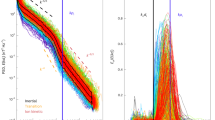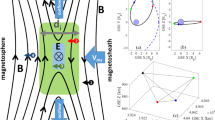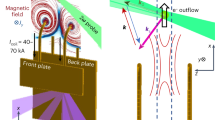Abstract
Turbulent magnetic reconnection is believed to occur in astrophysical plasmas, and it has been suggested to be a trigger of solar flares. It often occurs in long stretched and fragmented current sheets. Recent observations by the Parker Solar Probe, the Solar Dynamics Observatory and in situ satellite missions agree with signatures expected from turbulent reconnection. However, the underlying mechanisms, including how magnetic energy stored in the Sun’s magnetic field is dissipated, remain unclear. Here we demonstrate turbulent magnetic reconnection in laser-generated plasmas created when irradiating solid targets. Turbulence is generated by strongly driven magnetic reconnection, which fragments the current sheet, and we also observe the formation of multiple magnetic islands and flux-tubes. Our findings reproduce key features of solar flare observations. Supported by kinetic simulations, we reveal the mechanism underlying the electron acceleration in turbulent magnetic reconnection, which is dominated by the parallel electric field, whereas the betatron mechanism plays a cooling role and Fermi acceleration is negligible. As the conditions in our laboratory experiments are scalable to those of astrophysical plasmas, our results are applicable to the study of solar flares.
This is a preview of subscription content, access via your institution
Access options
Access Nature and 54 other Nature Portfolio journals
Get Nature+, our best-value online-access subscription
$29.99 / 30 days
cancel any time
Subscribe to this journal
Receive 12 print issues and online access
$209.00 per year
only $17.42 per issue
Buy this article
- Purchase on Springer Link
- Instant access to full article PDF
Prices may be subject to local taxes which are calculated during checkout




Similar content being viewed by others
Data availability
All data needed to evaluate the conclusions in the paper are present in the paper. Experimental data and simulations are available from the corresponding author upon reasonable request.
Code availability
The EPOCH code is used under UK EPSRC contracts (nos. EP/G055165/1 and EP/G056803/1).
References
Zweibel, E. & Yamada, M. Magnetic reconnection in astrophysical and laboratory plasmas. Annu. Rev. Astron. Astrophys. 47, 291–332 (2009).
Yamada, M., Kulsrud, R. & Ji, H. Magnetic reconnection. Rev. Mod. Phys. 82, 603–664 (2010).
Sweet, P. A. The neutral point theory of solar flares. Int. Astron. Union Symp. 6, 123–134 (1958).
Parker, E. N. Sweet’s mechanism for merging magnetic fields in conducting fluids. J. Geophys. Res. 62, 509–520 (1957).
Sych, R. et al. Relationship between wave processes in sunspots and quasi-periodic pulsations in active region flares. Astron. Astrophys. 505, 791–799 (2009).
Gosling, J. T. et al. Prevalence of magnetic reconnection at small field shear angles in the solar wind. Geophys. Res. Lett. 34, 15110 (2007).
Lemen, J. R. et al. The Atmospheric Imaging Assembly (AIA) on the Solar Dynamics Observatory (SDO). Solar Phys. 275, 17–40 (2012).
Pesnell, W. D., Thompson, B. J. & Chamberlin, P. C. The Solar Dynamics Observatory (SDO). Solar Phys. 275, 3–15 (2012).
Bárta, Miroslav et al. Spontaneous current-layer fragmentation and cascading reconnection in solar flares. I. Model and Analysis. Astrophys. J. 737, 24 (2011).
Takasao, Shinsuke et al. Observational evidence of particle acceleration associated with plasmoid motions. Astrophys. J. 828, 103 (2016).
Cheng, X. et al. Observations of turbulent magnetic reconnection within a solar current sheet. Astrophys. J. 866, 64 (2018).
Fox, N. J. et al. The Solar Probe Plus mission: humanity’s first visit to our star. Space Sci. Rev. 204, 7–48 (2016).
Zhao, L. L. et al. Spectral features in field-aligned solar wind turbulence from Parker Solar Probe observations. Astrophys. J. 898, 113 (2020).
Zank, G. P. et al. Turbulence transport in the solar corona: theory, modeling and Parker Solar Probe. Phys. Plasmas 28, 080501 (2021).
Parker, E. N. Topological dissipation and the small-scale fields in turbulent gases. Astrophys. J. 174, 499–510 (1972).
Parker, E. N. Nanoflares and the solar X-ray corona. Astrophys. J. 330, 474–479 (1988).
Vasquez, B. J. et al. Numerous small magnetic field discontinuities of Bartels rotation 2286 and the potential role of Alfvénic turbulence. J. Geophys. Res. 112, 11102 (2007).
Rappazzo, A. F. & Parker, E. N. Current sheets formation in tangled coronal magnetic fields. Astrophys. J. Lett. 773, L2 (2013).
Furth, H. P., Killeen, J. & Rosenbluth, M. N. Finite-resistivity instabilities of a sheet pinch. Phys. Fluids 6, 459–484 (1963).
Bhattacharjee, A., Huang, Yi-Min, Yang, H. & Rogers, B. Fast reconnection in high-Lundquist-number plasmas due to the plasmoid instability. Phys. Plasmas 16, 112102 (2009).
Lazarian, A. & Vishniac, E. T. Reconnection in a weakly stochastic field. Astrophys. J. 517, 700–718 (1999).
Shibata, K. & Tanuma, S. Plasmoid-induced-reconnection and fractal reconnection. Earth Planets Space. 53, 473–482 (2001).
Lin, J. et al. Features and properties of coronal mass ejection/flare current sheets. Astrophys. J. Lett. 658, L123–L126 (2007).
Loureiro, N. F., Schekochihin, A. A. & Cowley, S. C. Instability of current sheets and formation of plasmoid chains. Phys. Plasmas 14, 100703 (2007).
Ye, J. et al. The role of turbulence for heating plasmas in eruptive solar flares. Astrophys. J. 897, 64 (2020).
Zank, G. P. et al. Theory and transport of nearly incompressible magnetohydrodynamic turbulence. Astrophys. J. 835, 147 (2017).
Zank, G. P. et al. Spectral anisotropy in 2D plus slab magnetohydrodynamic turbulence in the solar wind and upper corona. Astrophys. J. 900, 115 (2020).
Nilson, P. M. et al. Magnetic reconnection and plasma dynamics in two-beam laser-solid interactions. Phys. Rev. Lett. 97, 255001 (2006).
Li, C. K. et al. Observation of megagauss-field topology changes due to magnetic reconnection in laser-produced plasmas. Phys. Rev. Lett. 99, 055001 (2007).
Nilson, P. M. et al. Bidirectional jet formation during driven magnetic reconnection in two-beam laser-plasma interactions. Phys. Plasmas 15, 092701 (2008).
Zhong, J. et al. Modelling loop-top X-ray source and reconnection outflows in solar flares with intense lasers. Nat. Phys. 6, 984–987 (2010).
Zhong, J. Y. et al. Relativistic electrons produced by reconnecting electric fields in a laser-driven bench-top solar flare. Astrophys. J. Suppl. 225, 30 (2016).
Rosenberg, M. J. et al. A laboratory study of asymmetric magnetic reconnection in strongly driven plasmas. Nat. Commun. 6, 6190 (2015).
Kuramitsu, Y. et al. Magnetic reconnection driven by electron dynamics. Nat. Commun. 9, 5109 (2018).
Kolmogorov, A. N. The local structure of turbulence in incompressible viscous fluid for very large Reynolds numbers. Doklady Akademiia Nauk SSSR. 30, 301–305 (1941).
Iroshnikov, P. S. Turbulence of a conducting fluid in a strong magnetic field. Soviet Astron. 7, 566–571 (1964).
Kraichnan, R. H. Inertial range spectrum of hydromagnetic turbulence. Phys. Fluids 8, 1385–1387 (1965).
Ng, C. S. & Bhattacharjee, A. Anisotropic MHD turbulence. AIP Conference Proceedings. 932, 137 (2007).
Alexandrova, O. et al. Universality of solar-wind turbulent spectrum from MHD to electron scales. Phys. Rev. Lett. 103, 165003 (2009).
Sahraoui, F. et al. Evidence of a cascade and dissipation of solar-wind turbulence at the electron gyroscale. Phys. Rev. Lett. 102, 231102 (2009).
Kiyani, K. H. et al. Global scale-invariant dissipation in collisionless plasma turbulence. Phys. Rev. Lett. 103, 075006 (2009).
Alexandrova, O. et al. Solar wind turbulent spectrum at plasma kinetic scales. Astrophys. J. 760, 121 (2012).
Kiyani, K. H., Osman, K. T. & Chapman, S. C. Dissipation and heating in solar wind turbulence: from the macro to the micro and back again. Phil. Trans. R. Soc. A 373, 20140155 (2015).
Boldyrev, S. & Perez, J. C. Spectrum of kinetic Alfvén turbulence. Astrophys. J. Lett. 758, L44 (2012).
Told, D. et al. Multiscale nature of the dissipation range in gyrokinetic simulations of Alfvénic turbulence. Phys. Rev. Lett. 115, 025003 (2015).
Cerri, S. S., Servidio, S. & Califano, F. Kinetic cascade in solar-wind turbulence: 3D3V hybrid-kinetic simulations with electron inertia. Astrophys. J. Lett. 846, L18 (2017).
Grošelj, D. et al. Fully kinetic simulation of 3D kinetic Alfvén turbulence. Phys. Rev. Lett. 120, 105101 (2018).
Willingale, L. et al. Fast advection of magnetic fields by hot electrons. Phys. Rev. Lett. 105, 095001 (2010).
Remington, B. A., Drake, R. P. & Ryutov, D. D. Experimental astrophysics with high power lasers and Z pinches. Rev. Mod. Phys. 78, 755–807 (2006).
Fiuza, F. et al. Electron acceleration in laboratory-produced turbulent collisionless shocks. Nat. Phys. 16, 916–920 (2020).
Beyer, K. A. et al. Analytical estimates of proton acceleration in laser-produced turbulent plasmas. J. Plasma Phys. 84, 905840608 (2018).
Jeffrey, NatashaL. S., Fletcher, L. & Labrosse, N. First evidence of non-Gaussian solar flare EUV spectral line profiles and accelerated non-thermal ion motion. Astron. Astrophys. 590, A99 (2016).
Polito, V. et al. Broad non-Gaussian Fe XXIV line profiles in the impulsive phase of the 2017 September 10 X8.3-class flare observed by Hinode/EIS. Astrophys. J. 864, 63 (2018).
Martínez-Sykora, J. et al. On the generation of solar spicules and Alfvénic waves. Science 356, 1269–1272 (2017).
Samanta, T. et al. Generation of solar spicules and subsequent atmospheric heating. Science 366, 890–894 (2019).
Pariat, E. et al. Resistive emergence of undulatory flux tubes. Astrophys. J. 614, 1099–1112 (2004).
Hou, Z. et al. Formation of solar quiescent coronal loops through magnetic reconnection in an emerging active region. Astrophys. J. 915, 39 (2021).
Wang, R. et al. Coalescence of magnetic flux ropes in the ion diffusion region of magnetic reconnection. Nat. Phys. 12, 263–267 (2016).
Zhang, B. & Yan, H. The internal-collision-induced magnetic reconnection and turbulence (ICMART) model of gamma-ray bursts. Astrophys. J. 726, 90 (2011).
Mendoza, M. et al. Modelling the influence of photospheric turbulence on solar flare statistics. Nat. Commun. 5, 5035 (2013).
Arber, T. D. et al. Contemporary particle-in-cell approach to laser-plasma modelling. Plasma Phys. Control. Fusion 57, 113001 (2015).
Fox, W., Bhattacharjee, A. & Germaschewski, K. Fast magnetic reconnection in laser-produced plasma bubbles. Phys. Rev. Lett. 106, 215003 (2011).
Dahlin, J. T., Drake, J. F. & Swisdak, M. The mechanisms of electron heating and acceleration during magnetic reconnection. Phys. Plasmas 21, 092304 (2014).
Wang, H., Lu, Q., Huang, C. & Wang, S. The mechanisms of electron acceleration during multiple X line magnetic reconnection with a guide field. Astrophys. J. 821, 84 (2016).
Drake, J. F., Swisdak, M., Che, H. & Shay, M. A. Electron acceleration from contracting magnetic islands during reconnection. Nature 443, 553–556 (2006).
Drake, J. F., Opher, M., Swisdak, M. & Chamoun, J. N. A magnetic reconnection mechanism for the generation of anomalous cosmic rays. Astrophys. J. 709, 963–974 (2010).
Acknowledgements
We acknowledge the Shenguang II staff for operating the laser facility, and the staff at CAEP for providing some diagnostics and target fabrication. We also thank H. Yan from Universitat Potsdam, J. Lin from YAOC and Q.M. Lu from the University of Science and Technology of China for valuable discussions. This work was supported by the National Key RD Program of China (grant nos. 2022YFA1603200 and 2022YFA1603203) and the National Natural Science Foundation of China (grant nos. 12175018, 12135001, U1930108, 12075030 and 11903006) and the Strategic Priority Research Program of the Chinese Academy of Sciences (grant no. XDA25030700).
Author information
Authors and Affiliations
Contributions
J. Zhong proposed the experiment. The experiments were carried out by B.H., W.S., C.X., J.W. and Z.L. The data were analysed by Y.P., J. Zhong, X.W. and Z.Z. The interference data were measured and analysed by J. Zhong, Y.Z. and D.Y. Numerical simulations were performed by Y.P. and H.Z. Additional theoretical support was provided by Y.L. and B.Q. Y.P., J. Zhong, X.W. and Y.L. contributed to writing of the manuscript. J. Zhu is responsible for running the laser facility. J. Zhang and G.Z. are the proposers and principal investigators of the laboratory astrophysics project.
Corresponding author
Ethics declarations
Competing interests
The authors declare no competing interests.
Peer review
Peer review information
Nature Physics thanks Vanessa Polito and the other, anonymous, reviewer(s) for their contribution to the peer review of this work.
Additional information
Publisher’s note Springer Nature remains neutral with regard to jurisdictional claims in published maps and institutional affiliations.
Extended data
Extended Data Fig. 1 Interferometric image analysis.
a and b, the interferograms in Case I with ds = 200μm and Case II with ds = 400μm respectively, for 1ns after lasers irradiation on the targets, and the bright spots are the laser irradiation positions, where the localised fringe shifts are presented and some darker zones break the fringe which imply the chaotic plasma density. c and d, the electron number density ne normalized by 1018cm−3 from the interferograms (a,b) are performed Abel inversion algorithm. Here, because the fringe is discontinuous, the inversion error is relatively large, especially in the fringe fracture area.
Extended Data Fig. 2 Measurement of magnetic field.
a, the evolution of the magnetic field probed by B-dot located 45mm from the center of the target in Case III where only one side part of target is irradiated by two lases corresponding two spots of the separation distance 400μm.
Extended Data Fig. 3 2D PIC simulation in Case I of the separation 20di.
The up row, the evolution of the magnetic field along X-direction Bx. The middle row, the evolution of the magnetic field along Y-direction By. The Unit of magnetic field is Tesla. The down row, the evolution of the electron number density ne which is normalized by 1024m−3. Here, ωci = eB0/mi is the ion gyro-frequency, and di is the ion inertial scale di = c/ωpi where \({\omega }_{pi}=\sqrt{4\pi {n}_{i}{e}^{2}/{m}_{i}}\), e is the element charge and mi is the ion mass with mi = 100me.
Extended Data Fig. 4 3D PIC simulations.
a and b, magnetic field along Y-direction By and electron number density in Case II where the magnetic and density tube are presented in the current sheet during MR. Here, the Bmax is about 189T and the unit of the electron number density is m−3. c, electron energy spectra in the current sheet which show non-thermal distributions and more energetic electrons in Case II than Case I. d, ion energy spectra in the current sheet and they are Maxwell distributions. dN/dE is the electron/ion energy distribution function.
Supplementary information
Supplementary Video 1
The electron number density evolution from 2D PIC simulation of Case I. Four density bubbles are generated as the lasers turned on, then expanded to form two dense sheaths, and eventually fragmented in the current sheet region.
Supplementary Video 2
The x-component evolution of the magnetic field, Bx versus t, by 2D PIC simulation of Case I. Four bubbles of Bx are created as the lasers turned on, and then expanded to form anti-parallel magnetic field regions. Eventually magnetic islands are generated due to reconnection.
Supplementary Video 3
The y-component evolution of the magnetic field, By versus t, by 2D PIC simulation of Case I. Four bubbles with By in opposite directions are created as the lasers turned on, and expanded. Then the adjacent By on the same side annihilates to form fine magnetic structures where By reconnects to generate islands in the current sheet region.
Rights and permissions
Springer Nature or its licensor (e.g. a society or other partner) holds exclusive rights to this article under a publishing agreement with the author(s) or other rightsholder(s); author self-archiving of the accepted manuscript version of this article is solely governed by the terms of such publishing agreement and applicable law.
About this article
Cite this article
Ping, Y., Zhong, J., Wang, X. et al. Turbulent magnetic reconnection generated by intense lasers. Nat. Phys. 19, 263–270 (2023). https://doi.org/10.1038/s41567-022-01855-x
Received:
Accepted:
Published:
Issue Date:
DOI: https://doi.org/10.1038/s41567-022-01855-x
This article is cited by
-
Recent progress on magnetic reconnection by in situ measurements
Reviews of Modern Plasma Physics (2023)
-
Electron scale magnetic reconnections in laser produced plasmas
Reviews of Modern Plasma Physics (2023)



